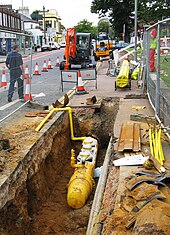Storage and transport
Polyethylene plastic main being placed in a trench.
 Because of its low density, it is not easy to store natural gas or transport by vehicle. Natural gas pipelines are impractical across oceans. Many existing pipelines in America are close to reaching their capacity, prompting some politicians representing northern states to speak of potential shortages. In Europe, the gas pipeline network is already dense in the West.[25] New pipelines are planned or under construction in Eastern Europe and between gas fields in Russia, Near East and Northern Africa and Western Europe. See also List of natural gas pipelines.
Because of its low density, it is not easy to store natural gas or transport by vehicle. Natural gas pipelines are impractical across oceans. Many existing pipelines in America are close to reaching their capacity, prompting some politicians representing northern states to speak of potential shortages. In Europe, the gas pipeline network is already dense in the West.[25] New pipelines are planned or under construction in Eastern Europe and between gas fields in Russia, Near East and Northern Africa and Western Europe. See also List of natural gas pipelines.LNG carriers transport liquefied natural gas (LNG) across oceans, while tank trucks can carry liquefied or compressed natural gas (CNG) over shorter distances. Sea transport using CNG carrier ships that are now under development may be competitive with LNG transport in specific conditions.
Gas is turned into liquid at a liquefaction plant, and is returned to gas form at regasification plant at the terminal. Shipborne regasification equipment is also used. LNG is the preferred form for long distance, high volume transportation of natural gas, whereas pipeline is preferred for transport for distances up to 4,000 km over land and approximately half that distance offshore.
CNG is transported at high pressure, typically above 200 bars. Compressors and decompression equipment are less capital intensive and may be economical in smaller unit sizes than liquefaction/regasification plants. Natural gas trucks and carriers may transport natural gas directly to end-users, or to distribution points such as pipelines.
Peoples Gas Manlove Field natural gas storage area in Newcomb Township, Champaign County, Illinois. In the foreground (left) is one of the numerous wells for the underground storage area, with an LNG plant, and above ground storage tanks are in the background (right).

No comments:
Post a Comment